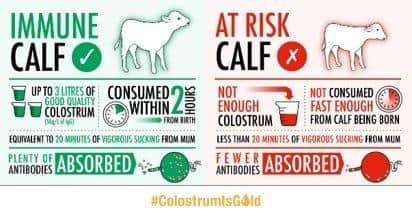Colostrum - it all starts on day one #colostrumisgold


This requires farmers to put in place different management strategies and use different tools compared to those of the past.
Every tool we have in the box must now be utilised. One underutilised management practise is the proper use of colostrum. Colostrum is one of the most accessible and cheapest disease prevention methods on farm and many farmers aren’t maximising its potential. Providing enough, high quality colostrum within the first six hours of life will reduce mortality and disease within the herd/flock.
About colostrum


Advertisement
Advertisement
So, what is so special about colostrum? Firstly, it provides antibodies that help form and develop many important parts of the immune system. New-born livestock have little body fat, meaning they are highly reliant on fats and carbohydrates contained within colostrum which can be used as a source to maintain growth and body
temperature. Secondly, colostrum provides many other nutrients including Vitamins A, D, and E. These vitamins help by increasing the absorptive and digestive capacity of the digestive system, enzymes, and proteins, which reduce the growth of harmful bacteria and contribute significantly to the immune system.
Colostrum intake
Calves should be fed up to three litres or 10 percent of the calves’ bodyweight of high-quality colostrum
(˃50 mg/ml of Immunoglobulin G (IgG) within two hours of birth and fed at 38˚c. This should be followed
Advertisement
Advertisement
by another similar quantity within 12 hours of birth. Antibody absorption efficiency from colostrum declines rapidly from over 40 percent at birth to less than five percent by 20 hours.
Lambs should be fed 50 ml/kg within two hours of birth. Total colostrum intake should be 210-290 ml/kg body weight within 24 hours of life. If necessary, always try to use colostrum from other ewes within the flock wherever possible as colostrum from cows can increase the risk of anaemia in lambs.
Reduction in antibiotics
Every farmer should have an aspiration to reduce the long term need for antibiotics. This can best be achieved by using what nature has given us in the best way possible. Colostrum is the first form of defence when it comes to an animal fighting off disease or infection. For example, calves do not begin to make their own antibodies until they are 21 days old, so colostrum provides the calves only form of protection up to this point.
Monitoring quality colostrum
Quality colostrum contains at least 50g/L of lgG. Colostrum containing less than 20g/L of IgG should not be fed. Quality of colostrum declines the longer it is in the udder as it begins to dilute and can become contaminated with bacteria.
Advertisement
Advertisement
To check your colostrum regime, you can ask your vet to blood test a batch of calves within one week ofbirth. At least 80 percent of the group should be designated as ‘good’.
Remember you cannot tell the quality of colostrum simply by looking at it! Only freeze colostrum from animals with a good health status, that are Johne’s free and that has a high immunoglobulins (IgG) status.
Future care
Future care is also important as good quality colostrum fed on time only contains a limited number of antibodies. You must maintain a suitable environment, provide suitable feed, and maintain high standards of hygiene in feed preparation and housing. As calves can spend 80 percent of their day lying down clean, dry bedding is essential.
Ewes must be fed correctly during pregnancy and especially during the last three weeks, as at this point the amount of protein and energy received will influence the quantity and quality of the colostrum produced.
Feeding adequate colostrum levels and applying the appropriate future care will give your livestock the best start in life and put them on a firm footing for a long, healthy and profitable future.